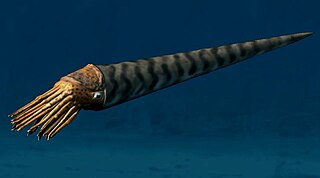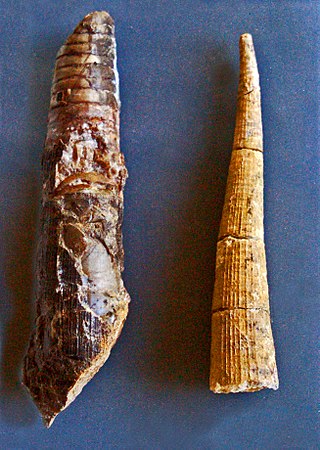
Orthoceratidae is an extinct family of actively mobile carnivorous cephalopods, subclass Nautiloidea, that lived in what would be North America, Europe, Asia, Africa, and Australia from the Ordovician through Triassic from 490—203.7 mya, existing for approximately 286.4 million years.
Discosorida are an order of cephalopods that lived from the beginning of the Middle Ordovician, through the Silurian, and into the Devonian. Discosorids are unique in the structure and formation of the siphuncle, the tube that runs through and connects the camerae (chambers) in cephalopods, which unlike those in other orders is zoned longitudinally along the segments rather than laterally. Siphuncle structure indicated that the Discosorida evolved directly from the Plectronoceratida rather than through the more developed Ellesmerocerida, as did the other orders. Finally and most diagnostic, discosorids developed a reinforcing, grommet-like structure in the septal opening of the siphuncle known as the bullette, formed by a thickening of the connecting ring as it draped around the folded back septal neck.
The Ellesmerocerida is an order of primitive cephalopods belonging to the subclass Nautiloidea with a widespread distribution that lived during the Late Cambrian and Ordovician.

The Oncocerida comprise a diverse group of generally small nautiloid cephalopods known from the Middle Ordovician to the Mississippian, in which the connecting rings are thin and siphuncle segments are variably expanded. At present the order consists of some 16 families, a few of which, such as the Oncoceratidae, Brevicoceratidae, and Acleistoceratidae contain a fair number of genera each while others like the Trimeroceratidae and Archiacoceratidae are represented by only two or three.

The Tarphycerida were the first of the coiled cephalopods, found in marine sediments from the Lower Ordovician to the Middle Devonian. Some, such as Aphetoceras and Estonioceras, are loosely coiled and gyroconic; others, such as Campbelloceras, Tarphyceras, and Trocholites, are tightly coiled, but evolute with all whorls showing. The body chamber of tarphycerids is typically long and tubular, as much as half the length of the containing whorl in most, greater than in the Silurian Ophidioceratidae. The Tarphycerida evolved from the elongated, compressed, exogastric Bassleroceratidae, probably Bassleroceras, around the end of the Gasconadian through forms like Aphetoceras. Close coiling developed rather quickly, and both gyroconic and evolute forms are found in the early middle Canadian.

Slender Oncoceratidae are those in the family Oncoceratidae, which have slender, commonly curved, shells. Some like Oocerina are gently curved, almost straight, and with only slight expansion. Others like Dunleithoceras are strongly curved with a more notable rate of expansion. Inclusion in this somewhat arbitrary category is based on illustrations in the Treatise Part K, 1964.
Jovellania is a genus of extinct prehistoric nautiloids from the order Oncocerida known from the Lower Devonian of Europe. Nautiloids form a broad group of shelled cephalopods that were once diverse and numerous but are now represented by only a handful of species in two genera.

Kionoceras is an extinct nautiloid cephalopod genus included in the orthocerid family Kionoceratidae with scattered worldwide distribution from the Middle Ordovician to the Lower Permian. Kionoceratids are orthocerids with prominent longitudinal ornamentation on their shells, sometimes augmented by secondary transverse ornamentation. Orthocerids are, of course, prehistoric nautiloides with generally straight and elongate shells, mostly with central or subcentral siphuncles.
Brevicoceras is an extinct nautiloid genus from the order Oncocerida with wide distribution in the Middle Devonian in Eastern North America, Russia and Morocco. Nautiloids form a broad group of shelled cephalopods that were once diverse and numerous but are now represented by only a handful of species in two genera.

Geisonoceratidae is an extinct family of orthoceroid cephalopods endemic to what would be Asia, Europe, and North America from the Middle Ordovician to the Middle Devonian living from about 470—380 mya, existing for approximately 90 million years. With the possible addition of an Early Cretaceous orthocerid from the western Caucasus the range of this group increases dramatically to some 350 million years, thus making it one of the longest lived families of the Nautiloidea.
Acleistoceras is a genus of the oncocerid, nautiloid family Acleistoceratidae that lived in the shallow seas that covered much of North America during the Devonian; living from 409—383.7 mya, existing for approximately 25.3 million years.

Dawsonoceratidae is an extinct family of orthoconic nautiloid cephalopods that lived in what would be North America and Europe from the Late Ordovician through the Middle Devonian from about 480–390 mya, existing for approximately 90 million years.
Basslerocerida is an order of nautiloid cephalopods from the Ordovician comprising exogastric longiconic cyrtocones, that is no longer in common use.
Jovellaniidae was established as a family within the Oncocerida to include genera characterized by longiconic orthocones and cyrtocones with a subtriangular to depressed cross-section in which the ventral (siphuncular) side is typically angular or more acutely rounded than the dorsal (antisiphuncular) side, and in which the siphuncle is generally large, ventral, and with lamellar actinosiphonate deposits

Oncoceratidae is a family of nauatiloid cephalopods in the order Oncocerida established by Hyatt, 1884, that range from the Middle Ordovician to the Upper Silurian.
The Bassleroceratidae is a family of gradually expanding, smooth ellesmerocerids with a slight to moderate exogastric curvature, subcircular to strongly compressed cross section, and ventral orthochaonitc siphuncle. The ventral side is typically more sharply rounded than the dorsal side and septa are close spaced. Connecting rings are thick and slightly expanded into the siphuncle, making the segments slightly concave; characteristic of the Ellesmerocerida.
The Tripteroceratidae is a family of depressed, straight to slightly curved nautiloid cephalopods from the middle and upper Ordovician with generally flattened venters and empty siphuncles with straight to inflated segments included in the Oncocerida.

The Phragmoceratidae is a family of extinct nautiloid cephalopods from the Order Discosorida that lived during the latter part of the Silurian.

Kionoceratidae is a family in the Orthocerida, proposed by Hyatt in 1900 for genera characterized by prominent ornamentation in the form of longitudinal ribs, ridges, or lirae, or combinations thereof, sometimes with similar transverse ornament or faint transverse annulations.
The Valcouroceratidae is a family within the Oncocerida, nautiloid cephalopods from the middle and upper Ordovician, established by Rousseau Flower in 1945.







